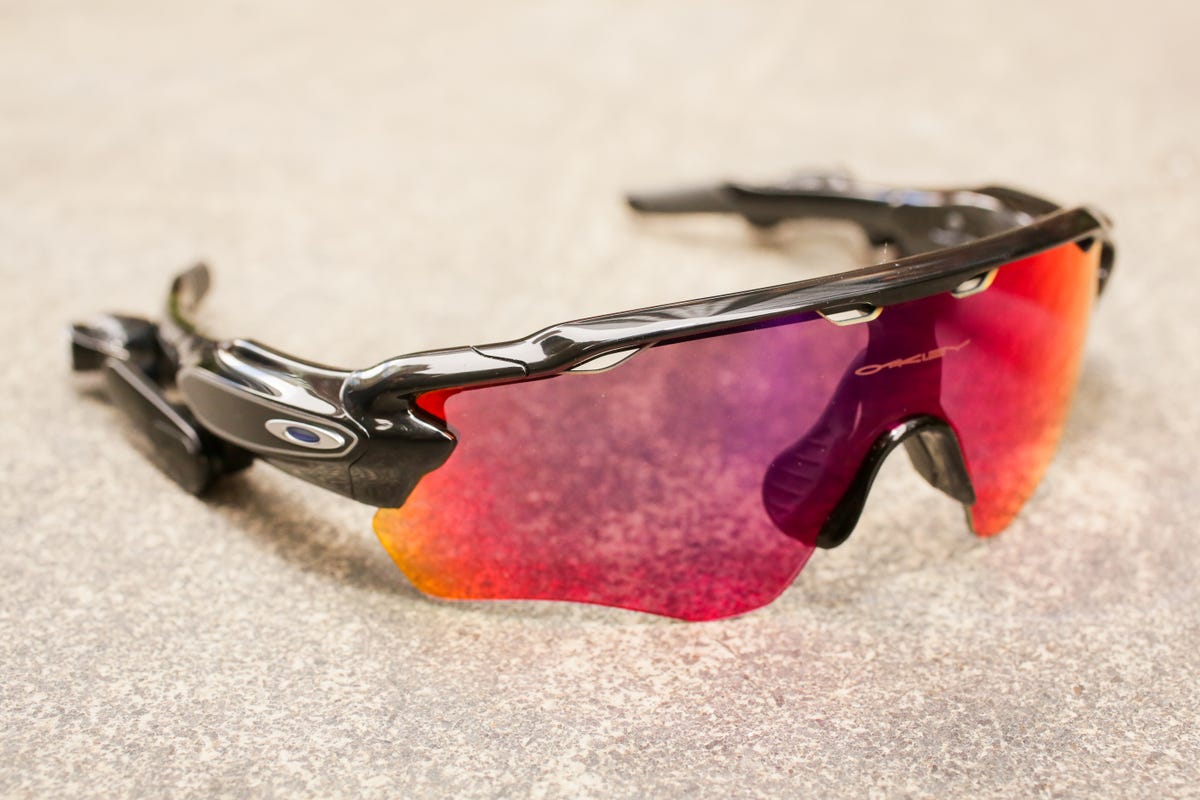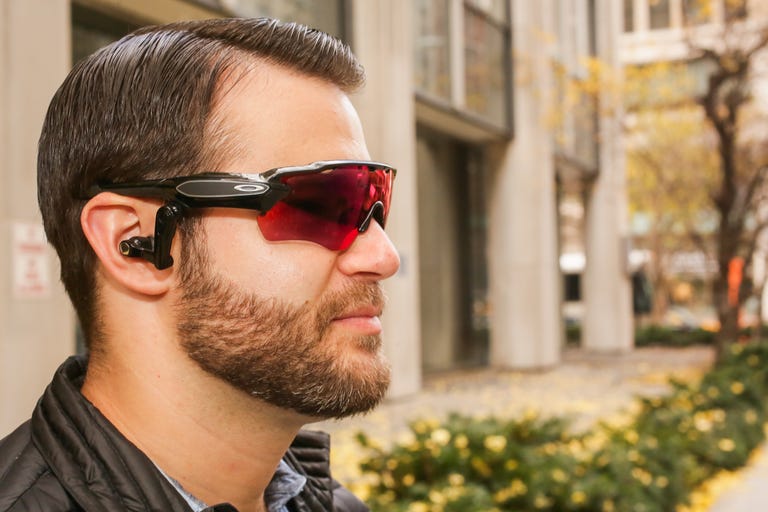 Why You Can Trust CNET
Why You Can Trust CNET Oakley Radar Pace review: Smart sunglasses are actually a great coach
The Radar Pace provides surprisingly good real-time coaching and performance feedback when you're running and cycling. You just look a bit odd talking to it.
I had coaches for most of my running career, six over the course of 11 years to be exact. From junior high and through to college, I had someone creating weekly running plans for me and coaching me to become a faster and stronger runner. That's a luxury not available to everyone, but to me, it matters.
The Good
The Bad
The Bottom Line
In recent years, I've relied on basic training plans available on the web, but nothing satisfied my needs. While most of these programs would provide a weekly workout schedule, few offered actual coaching.
That's why I was intrigued when I heard about Oakley's new workout sunglasses. The Oakley Radar Pace offers real-time coaching and feedback during your runs and bike rides, via audio cues over embedded Bluetooth headphones . The software can even create a weekly training plan that is tailored to you and your athletic ability. This isn't something that will replace your Fitbit. There's no step tracking and you wouldn't wear them throughout the day. These are used specifically to track running and cycling. And I really liked what it offered.
There are still some kinks that Oakley needs to work out, but the Radar Pace is still one of the most impressive devices I've tested in recent memory, and, at least for now, they're the best fitness-coaching wearable device I've ever used.
Just keep in mind the Radar Pace costs $450, £400 or AU$640, which is more than double the price of Oakley's normal, nonsmart Radar sunglasses. And it's a very different proposition than your average fitness-tracking running watch.
How do they work?
First of all, these aren't smart glasses, because they don't have any display in them. Alternative gadgets like the Recon Jet and Garmin Varia Vision can display workout info in real time through a head-up-display, but the Radar Pace is all about audio. It relies on a voice assistant (like Siri or Amazon's Alexa) to answer questions and provide coaching.

They're also excellent athletic sunglasses. They're lightweight, comfortable to wear and didn't bounce on my face during workouts. The frame is a little thicker than a normal pair of Oakleys, but that's due to extra sensors for measuring movement and elevation. These glasses have an accelerometer, gyroscope, barometer and humidity and proximity sensors, along with Bluetooth and ANT+ for pairing a heart rate strap, footpod, cycling power meter and speed or cadence sensors. But there's no GPS built-in, so you still have to workout with your phone.
On each side of the frame are Micro-USB ports. This is how you charge the Radar Pace and they're also used to attach the included earphone pieces, which allow you to hear your "coach" and listen to music streamed from your phone. The headphones can't be used without the glasses, but the glasses can be used without the headphones.
A touchpad on the left side of the frame changes songs, adjusts the volume and accepts calls. You can even long-press it to activate Siri or Google Now, but Oakley's voice assistant was more than adequate for all my midworkout questions.
Training with the Radar Pace
It's time to go for a run.
I turn the sunglasses on, put them on my face and then say, "OK, Radar." A small chime acknowledges that the Radar Pace is now listening. I ask, "What's my workout for today?" A female voice responds, "We are going 4.5 miles and climbing 190 feet." As my landlord watches me, I awkwardly respond, "OK, let's go."
It didn't take long for the feedback to come in. The music I was listening to softened, and the Radar Pace chimed in, "Your stride rate is low." I was hitting about 78 steps per minute, but the glasses let me know I should get to 88 steps for optimal performance. "Smaller, quicker steps," the voice told me. On another run, the glasses informed me that my pace was too fast and I should slow down since it was a recovery day.
This is the magic of the Radar Pace. Thanks to Intel's Real Speech technology, you can ask and respond to questions in a natural way. You can ask a question, such as, "How's my pace?" and then follow it up with, "Is that good?" Think of it as Alexa for fitness.
Voice controls are helpful, but they're also sometimes buggy. The glasses would sometimes pick up random grunts or surround noise as questions, dimming my music and throwing me off my rhythm. Most of the time, though, it accurately heard and responded to my commands. Here are just some of the questions you can ask:
- "How far have I gone?"
- "How am I doing?"
- "What's my heart rate?"
- "How long is this run?"
- "Why is stride rate important?"
- "How can I improve my performance?"
- "What's the time?"
Oddly enough, you can't use your voice to change songs or even pause your workout. The glasses auto-pause workouts when you stop moving, but there tends to be a slight delay in reaction time, which gets annoying in stop-and-go New York. That's my biggest concern with voice control outdoors: it won't always be practical, or even effective.
Creating a training program
Workout data is analyzed in real time and fed back to the glasses via the Radar Pace phone app. The app provides the option to go for a freeform run or bike ride, or to create a training program for either running or cycling. It's either one or the other, though, there isn't the option to create a training plan for both.
The setup is fairly simple. You choose your experience level, which ranges from first-time runner to serious podium hunter, and then choose what you're training for, a race or general fitness. You then pick which days you want to workout -- don't worry, it will also recommend the number of days required to achieve your goal.
From there, the Radar Pace will create a personally tailored workout plan. Depending on your goal, it will provide a schedule of how long and how hard you should run and bike each day. It will even adapt if you miss a workout, making runs or rides later in the week longer to make up for it. This is something I've seen before from companies like Polar and Nike, but the Radar Pace's highlight feature is the midworkout voice coaching, which is a feature others lack.
The downside
Oakley's phone app also needs work. I experienced occasional connection issues with my iPhone SE on iOS 10 (Android was fine). The Radar Pace would randomly disconnect midrun and wouldn't credit me with the miles I ran, which would affect my training plan. The app also doesn't sync with Strava, Garmin or other popular training apps. You are instead forced to manually export and import files from one app to another.
The only way to get credit for workouts is to run or bike while wearing the Radar Pace. That's a problem. I do a lot of my winter runs on the treadmill or when it's dark out. The sunglasses come with an extra set of clear lenses, but it still feels ridiculous wearing them (and talking to them) indoors or in the dark.
Battery life will vary based on usage. Listening to music will drop it down to around 4 hours, but otherwise you can expect up to 6 hours, which is the same as the Bose SoundSport Wireless headphones. I generally saw between 3 and 4 hours when listening to music and having a heart-rate chest strap paired, which was fine for running but not long enough for some of my long bike workouts.
Audio coaching is the future
The Radar Pace is an impressive idea. Its real-time feedback kept me on pace and made me conscious about shortening my stride. Will this make me a better runner in the long run? I don't yet know, but this surely is the most impressive coaching and training gadget I've tested in recent memory.
But there are obvious downsides. It's not something everyone will necessarily want to wear, and voice-only interactions can make for awkward moments. A high price limits the appeal, too. Sure, a normal pair of Oakley sunglasses cost around $200 (sometimes more), while a good pair of Bluetooth headphones can go for $100, which means you're really only paying $150 for the bonus coaching features. Real human coaches can cost upward of $200 a month. Will this coaching software be as good in the long run? It's unlikely, but it's much cheaper.
The Radar Pace is intriguing. It needs better support for third-party apps, and it needs to be more responsive, too. I'm not the kind of person who would buy expensive sunglasses, and I don't workout with music or my phone. But the Radar Pace's ability to deliver real-time data is unprecedented. It's made me a believer in audio feedback as a killer fitness tool.


